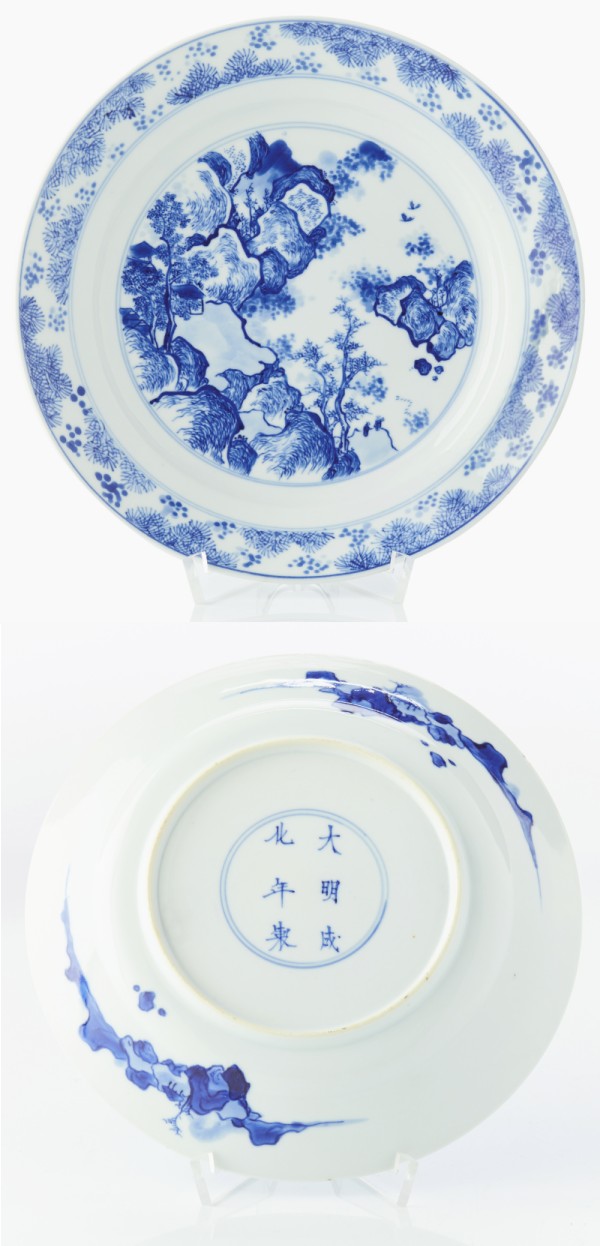
A Chinese 'Master of the Rocks' dish of circular form, decorated in shades of underglaze blue, expressively painted with towering boulders and pine, two birds in flight, the rim with a pine spray pattern, the reverse painted with further rockwork, the glazed base with an apocryphal six-character mark of Chenghua within a double circle in underglaze blue. Period: Kangxi (1662-1722). Diameter: 20 cm.
The 'Master of the Rocks', is a term that was coined by the English collector Gerald Reitlinger, whose collection is now in the Ashmolean Museum in Oxford, UK.
Master of the Rocks is a name given to a type of decoration found on early Kangxi porcelain. It has been suggested it was the work of one master decorator, but the variation in style indicates it must have been executed by different hands. The style is characterized by repeated close and parallel lines defining the landscape elements.
The rock masses and twisting rhythm running through the design reflect the painting style of Dong Qichang, a painter of the late Ming period whose style influenced many.
The style itself is characterized by the use of 'hemp-fibre' strokes, ie numerous parallel structure lines to produce rocky landscapes full of movement and drama, often combined with the use of fluid dots to depict scrub and foliage.
The use of 'hemp-fibre' brush strokes can be seen in the work of the famous late Ming dynasty scholar Dong Qichang (1555-1636), as mentioned above. The dramatic, almost writhing, rock forms as well as the 'hemp-fibre' brush strokes can also be seen in paintings such as Returning Home from Gathering Fungus painted in 1628 by Wang Jianzhang (fl. 1628-44), which is illustrated by S. Little in Chinese Porcelains of the Seventeenth Century - Landscapes, Scholars' Motifs and Narratives, J. B. Curtis (ed.), China Institute, New York, 1995, p. 36, fig. 2.
The style, which seems to have developed towards the mid-17th century in the final years of the Ming dynasty, continued to be popular into the early years of the Kangxi reign.
For a plate with this design see for example R.S. Kilburn, Transitional Wares and their Forerunners, The Oriental Ceramic Society of Hong Kong, 1981, p. 95, pl. 102.
The Dresden collection which belonged to Augustus the Strong has several pieces that can be assigned to the ”Master of the Rocks' style, see Eva Ströber, La Maladie de Porcelaine, East Asian Porcelain from the Collection of Augustus the Strong, Leipzig 2001, for a blue and white dish see, Porcelain Collection. PO 1357, dated to Shunzhi era (1644-1661) or early Kangxi era (1662-1722).
A dish in the collection of the Shanghai Museum bears rocks painted in very similar style. The Shanghai dish, illustrated by Wang Qingzheng (ed.) in Kangxi Porcelain Wares from the Shanghai Museum Collection, Hong Kong, 1998, pp. 8-9, no. 6, has copper red as well as underglaze blue decoration. The Shanghai example is also interesting because it has a dated inscription reading: Kangxi renzi Zhonghe Tang zhi' - 'made in the renzi year [AD 1672] of the Kangxi reign for the Hall of Propriety and Harmony'.
A